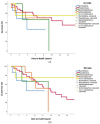Bacterial Re-Colonization Occurs Early after Lung Transplantation in Cystic Fibrosis Patients
- PMID: 33808547
- PMCID: PMC8003282
- DOI: 10.3390/jcm10061275
Bacterial Re-Colonization Occurs Early after Lung Transplantation in Cystic Fibrosis Patients
Abstract
Most cystic fibrosis (CF) patients referred for lung transplantation are chronically infected with Gram-negative opportunistic pathogens. It is well known that chronic infections in CF patients have a significant impact on lung-function decline and survival before transplantation. The rate and timing of re-colonization after transplantation have been described, but the impact on survival after stratification of bacteria is not well elucidated. We did a single-center retrospective analysis of 99 consecutive CF patients who underwent lung transplantation since the beginning of the Copenhagen Lung Transplant program in 1992 until October 2014. Two patients were excluded due to re-transplantation. From the time of CF diagnosis, patients had monthly sputum cultures. After transplantation, CF-patients had bronchoscopy with bronchoalveolar lavage at 2, 4, 6 and 12 weeks and 6, 12, 18 and 24 months after transplantation, as well as sputum samples if relevant. Selected culture results prior to and after transplantation were stored. We focused on colonization with the most frequent bacteria: Pseudomonas aeruginosa (PA), Stenotrophomonas maltophilia (SM), Achromobacter xylosoxidans (AX) and Burkholderia cepacia complex (BCC). Pulsed-field gel electrophoresis (PFGE) was used to identify clonality of bacterial isolates obtained before and after lung transplantation. Time to re-colonization was defined as the time from transplantation to the first positive culture with the same species. Seventy-three out of 97 (75%) had sufficient culture data for analyses with a median of 7 (1-91) cultures available before and after transplantation. Median colonization-free survival time was 23 days until the first positive culture after transplantation. After 2 years, 59 patients (81%) were re-colonized, 33 (48.5%) with PA, 7 (10.3%) with SM, 12 (17.6%) with AX, and 7 (10.3%) with BCC. No difference in survival was observed between the patients colonized within the first 2 years and those not colonized. Re-colonization of bacteria in the lower airways occurred at a median of 23 days after transplantation in our cohort. In our patient cohort, survival was not influenced by re-colonization or bacterial species.
Keywords: colonization; cystic fibrosis; lung transplantation.
Conflict of interest statement
The authors declare no conflict of interest.
Figures




Similar articles
-
Denitrification by cystic fibrosis pathogens - Stenotrophomonas maltophilia is dormant in sputum.Int J Med Microbiol. 2015 Jan;305(1):1-10. doi: 10.1016/j.ijmm.2014.07.002. Epub 2014 Aug 10. Int J Med Microbiol. 2015. PMID: 25441256
-
Chronic Airway Colonization by Achromobacter xylosoxidans in Cystic Fibrosis Patients Is Not Sustained by Their Domestic Environment.Appl Environ Microbiol. 2018 Nov 15;84(23):e01739-18. doi: 10.1128/AEM.01739-18. Print 2018 Dec 1. Appl Environ Microbiol. 2018. PMID: 30217850 Free PMC article.
-
High Occurrence of Bacterial Competition Among Clinically Documented Opportunistic Pathogens Including Achromobacter xylosoxidans in Cystic Fibrosis.Front Microbiol. 2020 Sep 10;11:558160. doi: 10.3389/fmicb.2020.558160. eCollection 2020. Front Microbiol. 2020. PMID: 33013789 Free PMC article.
-
Bacteriology and treatment of infections in the upper and lower airways in patients with primary ciliary dyskinesia: adressing the paranasal sinuses.Dan Med J. 2017 May;64(5):B5361. Dan Med J. 2017. PMID: 28552099 Review.
-
Pathophysiology and management of pulmonary infections in cystic fibrosis.Am J Respir Crit Care Med. 2003 Oct 15;168(8):918-51. doi: 10.1164/rccm.200304-505SO. Am J Respir Crit Care Med. 2003. PMID: 14555458 Review.
Cited by
-
The In Vitro Replication Cycle of Achromobacter xylosoxidans and Identification of Virulence Genes Associated with Cytotoxicity in Macrophages.Microbiol Spectr. 2022 Aug 31;10(4):e0208322. doi: 10.1128/spectrum.02083-22. Epub 2022 Jul 20. Microbiol Spectr. 2022. PMID: 35856670 Free PMC article.
-
Antibiotic Therapy for Difficult-to-Treat Infections in Lung Transplant Recipients: A Practical Approach.Antibiotics (Basel). 2022 May 2;11(5):612. doi: 10.3390/antibiotics11050612. Antibiotics (Basel). 2022. PMID: 35625256 Free PMC article. Review.
-
Ceftolozane/Tazobactam for the Treatment of Adults With Cystic Fibrosis: Results From a French Prospective Cohort Study.Open Forum Infect Dis. 2024 Aug 6;11(8):ofae391. doi: 10.1093/ofid/ofae391. eCollection 2024 Aug. Open Forum Infect Dis. 2024. PMID: 39108933 Free PMC article.
-
Detection of Bacterial Colonization in Lung Transplant Recipients Using an Electronic Nose.Transplant Direct. 2023 Sep 20;9(10):e1533. doi: 10.1097/TXD.0000000000001533. eCollection 2023 Oct. Transplant Direct. 2023. PMID: 37745948 Free PMC article.
-
Thoracic Ultrasound in Lung Transplantation-Insights in the Field.Life (Basel). 2023 Mar 4;13(3):695. doi: 10.3390/life13030695. Life (Basel). 2023. PMID: 36983850 Free PMC article.
References
-
- Orens J.B., Estenne M., Arcasoy S., Conte J.V., Corris P., Egan J.J., Egan T., Keshavjee S., Knoop C., Kotloff R., et al. International guidelines for the selection of lung transplant candidates: 2006 update—A consensus report from the Pulmonary Scientific Council of the International Society for Heart and Lung Transplantation. J. Heart Lung Transplant. 2006;25:745–755. doi: 10.1016/j.healun.2006.03.011. - DOI - PubMed
LinkOut - more resources
Full Text Sources
Other Literature Sources

